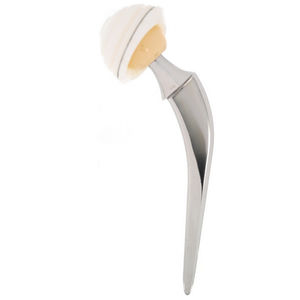

- Products
- Catalogs
- News & Trends
- Exhibitions
Revision acetabular prosthesis Capitole® Icementless
Add to favorites
Compare this product
Characteristics
- Surgical application
- revision
- Fixation type
- cementless
- Acetabular cup diameter
Min.: 45 mm
(1.77 in)Max.: 63 mm
(2.48 in)
Description
Originally created in the mid 70’s by Professor Gilles BOUSQUET in St Etienne (France), the dual articulation acetabular socket rationale has kept improving since then, and offers nowadays a comprehensive solution to intra-prosthetic dislocation.
Indicated for primary arthritis patients above 70 years old, for femoral neck fractures whenever the patient is valid and active, for any patient presenting an important hip joint laxity, for patients with irrational behaviour, and for most hip revision cases, the dual mobility concept combines a high level of protection against dislocation and a controled and well documented polyethylene wear rate.
CAPITOLE T: COPYING THE ORIGINAL
The CAPITOL T cup keeps the “Tripod” fixation imagined from the origins of his experience by Professor Bousquet. The clinical publications showing the largest follow-ups deal only with the “tripod” cup.
Its principle of fixation is based on the theory of the ” 3 feet stool “: the principle is a spontaneous stability whatever the ground.
2 pegs of fixation are set to the cup by conical fixation, and are directed in the branches of the ischion and the pubis. The third point of fixation is a screw oriented 15 – 20 ° above the horizontal in the roof of the acetabulum.
This principle proved an excellent long-term stability in spite of the original coating which did not allow any bony fixation to the cup.
CAPITOL T renews this original concept by adding a dual coating of porous titanium and hydroxyapatite.
Related Searches
- Surgery tweezers
- Ablation forceps
- Femoral stem
- Clamp forceps
- Knee prosthesis
- Acetabular prosthesis
- Cementless femoral stem
- Press-fit acetabular prosthesis
- Bone-cutting forceps
- Hip prosthesis
- Bone cement
- Orthopedic surgery bone cement
- Revision femoral stem
- Primary hip prosthesis
- Shoulder prosthesis
- Orthopedy forceps
- Cemented knee prosthesis
- Mobile-bearing knee prosthesis
- Cemented acetabular prosthesis
- Revision acetabular prosthesis
*Prices are pre-tax. They exclude delivery charges and customs duties and do not include additional charges for installation or activation options. Prices are indicative only and may vary by country, with changes to the cost of raw materials and exchange rates.











